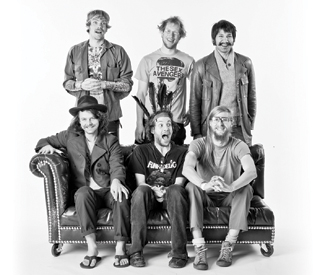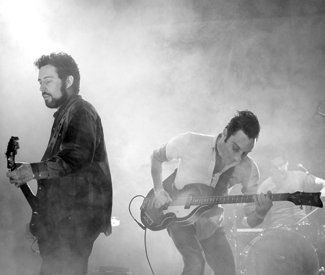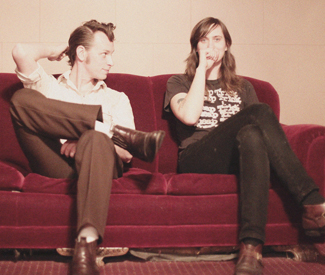emilysavage@sfbg.com
MUSIC In an airy third-floor loft in SOMA, not far from the Sightglass Coffee flagship and an antique mall with a pennant flag twisting out front, 20 filmmaking teams shuffle across a makeshift finish line some time before 8pm Sunday evening. Exhausted, they hold in their hands a digital file, the physical evidence of a brand new project — a joint effort between Bay Area bands, directors, producers, and editors. Something of this magnitude would traditionally take weeks or even months to complete, but in this focused case, it was all completed in a thrilling 48-hour period.
Flash back to the start of the weekend; it’s Friday night in the lower-level grotto of Sports Basement on the Mission-Potrero border, and everyone is huddled near complimentary Lagunitas beer. There’s a buzzy sense of anticipation. The bands and solo artists — truly diverse in sound and geography — are waiting to hear which filmmaking team they’ll be paired with for the remainder of the weekend.
For this is the second annual Music Video Race competition, and they’ll only have a short time to complete the project. Sure, given modern technology such as iPhones, basic music videos can now be made in a day (see Kitty Pryde, or other web-bred artists), but this is about the competition within the timeframe; the race pits artists against one another to see who can come up with the best concept and execution in the allotted two-day period.
Among the crowd, there’s young and quick-tongued Mission rapper A-1, bouncy power-pop act Giggle Party, groovy Ethiopian blues Sun Hop Fat, forest country-folk Whiskerman, dancey electro-pop duo Happy Fangs, vintage jazz crooner Quinn DeVeaux, and dreamy “post-indie” Magic Fight.
The names of filmmaking teams and bands are yelled out, and the room grows loud with introductions. “Have a blast, and thanks for playing!” (The next time they’ll be in the same room together will be the screening Sat/15 at Rickshaw Stop.)
Magic Fight gets paired with first-time music video director Cory K. Riley, an eager young filmmaker who says he cashed in just about every favor he had for this production (along with some online donations and money from his own pocket). He has a crew of three or four with him at Sports Basement tonight. “We’re definitely the messier one to follow,” Riley tells me with a wink. After they’re paired, the band and the Riley crew walk outside on this warm weekend evening, and pop the Magic Fight CD into Riley’s hatchback. It’s the first listen. Until moments before, they were all strangers on the local independent arts scene.
The match up of the bands and filmmakers seems almost up to dumb luck when the pairings are read aloud, a split-second decision and boom! Now there are new teams racing across the Bay with wild costumes and characters. But it’s actually months of hard work for co-organizers Tim Lillis and Jacquelyn “Jax” Marker. They pore over submissions, choose the pairings, find the sponsors, and host the happy hours leading up to the weekend.
They came up with the idea for the Music Video Race in 2011, while having drinks at Lucky 13 before a Mister Heavenly show — you know, that band in which Michael Cera intermittently played bass. “It came about talking about our friends that were in bands that needed music videos, and also our filmmaking friends that were either in corporate jobs, not getting as much creative release as they may like, or our filmmaking friends that had been sitting on something for two years that had never seen the light of day,” Marker says.
Plus, Marker and Lillis had together participated in the 48 Hour Film Festival, so they knew the thrill of the creative weekend. (“It was horrible,” Marker says with a laugh, of their joint project for that fest, which also challenges filmmakers to come up with a quality product in two days. “I directed it, and I’m a really good producer, not so much a director.”)
For the Music Video Race, the key objectives of the project were to create something fun, collaborative, and finite — with a clear ending time. “With this there’s an element of control,” Lillis says. “The song is the control, right?” He likens the organization to something like a very dialed-in Treasure Island, where the bands shift like clockwork. “I’m kind of production nerd, as well,” he says. While Lillis now works as a freelance illustrator and plays in an as-yet-unnamed band in San Francisco, in his former life in Boston, he did event production for Kaiju Big Battel, which pits costumed Godzilla-type characters against on another in a traveling steel cage.
Marker grew up in Sydney and came to San Francisco in ’06 for what was going to be a one-month project for Mythbusters. She begged her producers to let her stay in SF, which she did until late ’11. Now she’s back in Australia as a TV producer there, but was here for two months in 2012 for the first Music Video Race, and flew in for 10 days to be back in SF for the race this year. In the months leading up to each, there was a lot of organizing via Skype.
The 2012 videos were screened at a sold-out Rickshaw Stop show, where doppio’s video for “Beware of Cobra,” directed by filmmaking team the Outer Avenues, won overall. But beyond that, the videos gained artists more recognition. WATERS’ Vidola Productions-created video for “Mickey Mantle” premiered on the popular music blog Consequence of Sound, and the French Cassettes “Mouth Drum” video nearly went viral, earning director Dalan McNabola a few additional music video shoots from the exposure.
There are actual prizes too, including recording time with an engineer at Studio SQ for the bands, gear rental from popular grip and electric house DTC for the filmmakers, classes through TechShop, Vimeo memberships, Bay Area Video Coalition memberships, and more. A panel of judges including Noise Pop staff, and Bay Guardian film editor Cheryl Eddy (who, full disclosure, accepted judging responsibilities after I began work on this story), will choose the winners.
Still, the real goals of the race are collaboration and artistic expression. “I don’t think anybody is looking for this weekend to make them famous,” Lillis say. In what feels like direct contrast to the ethos of the Music Video Race, elsewhere in the city this weekend was the Chipotle Cultivate Festival, a free outdoor concert in Golden Gate Park with “Chipotle Eats” meals available for purchase.
“This is a passion project for us,” says Marker. “We both have full-time jobs while we put this on. What do we get out of this? It was definitely the most fun weekend I had of 2012. It was a year of work into 48 hours. And it’s about what other people get out of it, you know?”
Depending on how this year goes, Marker and Lillis are hoping to expand the Music Video Race to other cities, including Boston, Austin, and Sydney so far, just based on their own personal connections in these places. But before that, they’ll need to get through the weekend of this second annual competition.
“[You hope that] everybody just gets along, but you kind of want some craziness,” Marker says.
“There are a lot of personalities in the room. But everyone comes to it with a good attitude,” Lillis adds.
#MVRSF
At 10am the next morning after the race kickoff, inside the stuffy SUB-Mission venue space, the Cory K. Riley cast and crew seems to have tripled in size. Along with Riley, there’s producer Stuart Griese, director of photography Ryan Thomas, gaffer Matt Stouppe (Thomas and Stouppe own their own company, RTMS), first assistant director Alun Lee, art director Norah Hoover, makeup artist Laura Grassi, and a likely half a dozen more milling about, at any given moment.
There’s professional lighting and camera equipment from DTC laced throughout the cavernous three-room space, a snack table at the bar near the front with chorizo and egg burritos, tortilla chips and hummus, a big bottle of OJ, fresh fruit. And there are colorful Cosby sweaters and other clothing on the center stage of the venue, splayed out by the band as possible wardrobe choices.
Soon enough, Magic Fight will be windblown with twigs, spritzed in the face with water, dragged on the ground, and surrounded by beautiful young women in island-print dresses and coolly detached expressions.
But long before that, the four men of Magic Fight are hanging out front of the electric blue building, eating breakfast and waiting to shoot the first scene of the as-yet-unknown concept. They have a naturally light and upbeat energy between them, frequently joking with one another, ribbing, making puns, laughing; you’d never guess they were such a friendly bunch based on the somber tone of the song we’ll hear repeated all day as the cameras roll.
“Grand Children,” is an emotional indie pop rollercoaster off the band’s April 2013 album Wooden Swords and Stolen Echoes. The chorus methodically repeats the lyrics, “I want to die,” as octaves slowly rise and fall like rolling waves beneath them. There’s the sound of literal waves subtly crashing beneath the track as well, along with Alex Haager’s distressed vocals and gentle ukulele plucking, Alex Pinto’s bass, Jeff Gist’s steady drumming, and Hernando Buitrago’s twinkling keys.
The band members agree they’re all a part of the Music Video Race because of Buitrago. “I went to the [Music Vide Race] screening last year,” he explains. “I saw that Tim had a gathering at Hotel Utah a month ago, and I went — no one else wanted to go with me, but I went.” All laugh in unison. “I met Tim and he was down with having Magic Fight in it.”
“It was one of our classic email conversations that start between the hours of 2am and 8am, which seems to be how we communicate in this band,” Pinto says.
“I seem to remember a lot of screaming and finger-pointing,” Gist adds with one of his frequent sly smiles.
“Hernando has really good ideas, so we trust him,” Pinto concludes.
Haager and Buitrago say they first met at the Little Shamrock in the Inner Sunset over a game of backgammon, which Haager lost. That was the only game they played, but they ended up playing music together, or so the story goes. The others knew Buitrago through mutual friend Jessica Nguyen, a.k.a the Bicycle Bánh Mì owner.
They’re each talented in their own right, all in their late 20s, having played in various bands before coming together as this foursome for the first time in October of 2012 at Public Works. Previously, Haager conceived of Magic Fight as some sort of an electro-pop solo project — there’s an old Myspace page out there to prove it. He also played in Berlin and Brooklyn based quartet Hungry, Hungry Ghost.
And Pinto plays in his own jazz trio — which actually played its last SF show the night of the Music Video Race shoot — and also organizes the experimental jazz SF Offside Festival. He’ll be leaving Magic Fight too, at the end of summer, when he moves with his wife to India on a Fulbright Scholarship, where he’ll be creating new music content in jazz studies with South Indian classical music at the Swarnabhoomi Academy of Music (his father grew up near the area). Though, he jokes, he may try to bring the band out to India for one show, his last performance with Magic Fight will be July 14 at Brick and Mortar Music Hall.
The band and I have kept up with others in the race through the hashtag #MVRSF on Instagram and Twitter. Everyone’s been posting photos and geotagging their locations, tweeting about their late nights and crazy shoots. But at this point, Magic Fight has yet to film a scene. “People were shooting all night long,” Buitrago says incredulously. “They were like, ‘Wrapping up! Four in the morning.'” Through the hashtag, we see scenes of ninjas in sports cars, bands playing in the park and at the beach, children with war-paint, balloons for days, and tiny voodoo dolls.
Later, Marker and Lillis tell me they were able to visit 11 different sets on Saturday: “We discovered A-1 literally underneath his apartment building covered in dust and cobwebs; Animal Friends were conducting some sort of healing ritual in a Mission apartment; we walked into a house in Oakland to find two guys from Battlehooch dangling another member out of a house window; we caught a werewolf arm wrestling a woman at dusk down past Third Street. Oh the funniest by far was rocking up to the parking lot at Secret Studios and finding what we first thought was an abandoned set but then heard the members of Giggle Party screaming from inside the parked box truck.”
“Magic Fight’s set up had the most manpower and fancy gear for sure.”
HURRICANE SEASON
An hour or so after Magic Fight finish hanging out in front of SUB-Mission with breakfast burritos, Haager is wearing one of his colorful knit sweaters inside the darkened middle room of the venue, and there’s a bright halo of lights aimed directly on his face. He starts on a depressed blue couch covered in braches, leaves, flora debris, gets up and walks toward the camera with a piercing yet forlorn expression, mouthing along to the words of “Grand Children.”
The impressively large crew walks backward, carrying heavy-duty film equipment, lights, and coiled chords. Two additional crew members hoist an industrial-strength fan near Haager and throw even more leaves near him and the pieces shoot across his chest, face, hair. A 20-second bit of “Grand Children” is playing in the background so he knows which words to mouth, but the fan is too loud now and he cracks a smile. Cut, back to one.
Once they get the shot, Haager is flat on his back on the cool ground and Gist and Pinto are pulling him. He’s again mouthing along, this time with a vintage mic in his hand, attached to a tiny amp on his chest. Riley sprays Haager with a bottle of water as he slides. Still, it’s not entirely clear what is going on here, what will bring this all together as a concept.
Many of the crew members are also unsure, but trust Riley’s vision. He seems to thrive in the chaos, pulled like taffy in different directions, and asked his opinion on every factor. Tall and thin, with dark arching eyebrows and a beanie pulled down over a shaved head, he’ll give copious high-fives, frequently ask how everyone is doing, and use the phrase “viciously entertaining” multiple times throughout the weekend.
It’s set designer-art director Nora Hoover who finally enlightens with what’s going on, and then it all clicks: the swirling chaos of water, leaves, branches, twigs, and pink flowers, the women in Hawaiian dresses and leis. Hoover and Riley were up early in the morning picking up most of these pieces at a prop warehouse in South San Francisco, in a situation Riley described to Hoover as “just like Supermarket Sweep.”
The music video would have a dystopic feel, sad yet hopeful: a thrashing hurricane in picturesque Hawaii.
It’s a set location Riley knows something about. He grew up on Kauai, and Hoover lived there for a few months one winter. The two — who met on the set of a Kacey Johansing music video — connected over this.
Riley tells me the concept grew while he, Hoover, and producer Griese drove around the Mission Friday night after they left Sports Basement, listening over and over to the Magic Fight song. As they drove, Riley threw out words and connections in a stream-of-consciousness manner — “rain! leaves!” — while Griese scribbled down the ideas.
“I had pinks, whites, greens,” Riley says of the set aesthetic. “It was [supposed to be like] the late ’60s, thinking of a postcard for those old airlines, like, ‘Come to Waikiki!’ I felt like there was a mod ’60s kind of feel to the sound, whoever recorded the [Magic Fight] album that way, and there’s a line in the song that said, ‘I’ve never been to Hawaii.'”
All of these elements come together in the late afternoon scene. Riley points to the back room, which is being dressed by Hoover and more set designers. He smiles then winks, “that’s going to be a little bit of a freak show.”
The backdrop is breathtaking. It’s lit up bright white, with a big, twinkly arch of pink flowers and branches, a large black circular bed on the ground also covered in leaves. The women in island dresses stand behind Haager and slowly hula. There are other ladies propped languorously behind him, lounging with outstretched legs in a wicker chair, or on a raised bed with a vintage suitcase behind the action. I later find out they were the girlfriends and close pals of the crew, called in that morning to help out. Leaves and other fragments fall from the balcony.
From behind the camera, it looks beautiful — but will it be enough to win the race? Riley, his crew, and the band will find out this weekend at the Rickshaw Stop, where all the videos will be shown for the first time, and Magic Fight just happens to be playing live. “Even if you lose the race, you end up with a video, which is winning,” says Haager.
MUSIC VIDEO RACE SCREENING
With Magic Fight and Animal Friend
Sat/15, 7:30pm, $12–$15
Rickshaw Stop
155 Fell, SF
www.rickshawstop.com
ADDITIONAL SCREENING
Sun/16, 7pm, $10
Opera Plaza Cinemas
601 Van Ness, SF
www.landmarktheatres.com
























